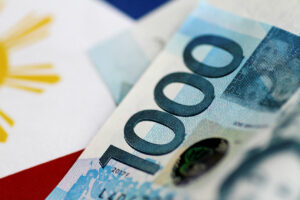NG debt slips to P14.93 trillion as of end-March
THE NATIONAL GOVERNMENT’S (NG) outstanding debt slipped to P14.93 trillion as of end-March, the Bureau of the Treasury (BTr) reported. Data from the BTr on Wednesday showed that NG debt stock dipped by 1.67% from the record-high P15.18 trillion as of end-February due to the net redemption of government securities. However, outstanding debt rose by […]

THE NATIONAL GOVERNMENT’S (NG) outstanding debt slipped to P14.93 trillion as of end-March, the Bureau of the Treasury (BTr) reported.
Data from the BTr on Wednesday showed that NG debt stock dipped by 1.67% from the record-high P15.18 trillion as of end-February due to the net redemption of government securities.
However, outstanding debt rose by 7.71% from P13.86 trillion in the same period a year ago.
 Year to date, the debt portfolio went up by 2.12% from P14.62 trillion as of end-December 2023.
Year to date, the debt portfolio went up by 2.12% from P14.62 trillion as of end-December 2023.
As of end-March, more than two-thirds or 68.86% of debt came from domestic sources.
Domestic debt declined by 2.83% to P10.28 trillion as of end-March from P10.58 trillion in the previous month. However, it increased by 8.03% from P9.51 trillion a year ago.
Government securities accounted for nearly all domestic debt as of end-March.
“The decline (in domestic debt) resulted from the P299.45-billion net redemption of government securities offsetting the P0.24-billion effect of peso depreciation on foreign currency domestic debt,” the BTr said in a statement.
Data from the BTr showed the peso weakened by 8.6 centavos to P56.26 against the dollar at end-March from P56.174 at end-February.
Meanwhile, external debt inched up by 1% to P4.65 trillion as of end-March from P4.6 trillion as of end-February. Year on year, it went up by 7.01% from P4.34 trillion.
“The increase resulted from the net availment of foreign loans amounting to P44.01 billion, as well as local currency depreciation which added to the valuation of US dollar-denominated debt by P7.05 billion. This more than offset the P4.83-billion impact of the appreciation in third currencies against the dollar,” the BTr said.
External debt was composed of P2.22 trillion in loans and P2.43 trillion in global bonds.
The NG’s guaranteed obligations inched up by 0.3% to P346.04 billion as of end-March from P344.93 billion in the previous month.
“The increment in the level of NG guarantees was due to the net availment of domestic guarantees amounting to P2.48 billion and the P0.25-billion effect of local currency depreciation against the US dollar on external guarantees,” the BTr said.
“On the other hand, the net repayment of external guarantees offset P1.15 billion while the net appreciation on third-currency denominated guarantees trimmed P0.47 billion,” it added.
Year on year, guaranteed obligations declined by 9.9% from P384.12 billion.
Rizal Commercial Banking Corp. Chief Economist Michael L. Ricafort said that the government’s repayment of maturing debt reduced the overall debt stock.
“The month-on-month decline in outstanding NG debt largely brought about by the large maturities of retail Treasury bonds (RTB) in early March 2024, though offset by earlier record RTB issuance in the latter part of February 2024,” he said.
Outstanding debt could also further increase amid future global bond offerings, elevated interest rates and further weakening of the peso.
JAPAN LOANS
Meanwhile, the Department of Finance (DoF) said it has lined up $1.5 billion worth of projects with the Japan International Cooperation Agency (JICA) from this year until 2025.
“The DoF is set to execute around $1.5 billion worth of pipeline projects with JICA for 2024-2025, and is working towards executing four major loan agreements within the year,” it said in a statement on Thursday.
The loan agreements will cover projects on maritime safety, roads, and flood risk management.
“Aside from the usual portfolio of infrastructure projects funded by JICA, the agency shared that it is expanding into other sectors that are in line with the Marcos administration’s development objectives, such as agriculture, education, and health,” it added.
The DoF and JICA are set to finalize the signing of the projects before the end of the year.
JICA is planning to commit an annual average of about $1.6 billion until 2027 for the country, it added.
The Finance department also said that JICA is looking into co-financing the Climate Change Action Program (CCAP), Subprogram 2. The program aims to ramp up the implementation of national climate policies.
As of end-December, the JICA was the Philippines’ top source of official development assistance, accounting for 32.8% of the total or $12.3 billion. — Luisa Maria Jacinta C. Jocson


















